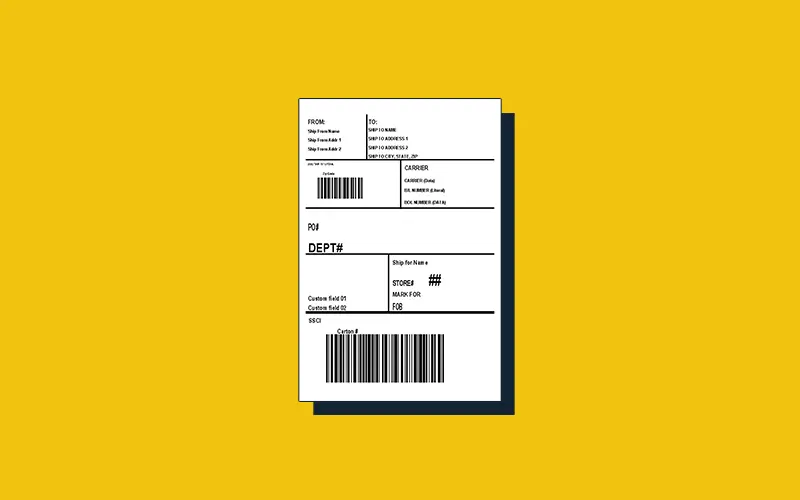
In the world of logistics and supply chain management, efficient tracking and identification of products are essential. To streamline this process, the Uniform Code Council (UCC) developed the UCC-128 label, a standardized barcode label system that has become integral to the modern supply chain. This article aims to explain what a UCC-128 label is and explore its diverse range of applications across various industries.
What is a UCC-128 Label?
A UCC-128 label, also known as a GS1-128 label, is a type of barcode label used for shipment and logistics purposes. It utilizes GS1 standards, which were originally developed by the UCC and now maintained by GS1, a global standards organization. This label format is designed to encode crucial information about a product or shipment, allowing businesses and logistics providers to identify, track, and manage their goods efficiently.
The UCC-128 label contains a series of data elements represented by a combination of bars and spaces, which can be read by barcode scanners. These elements can include the item’s Global Trade Item Number (GTIN), serial numbers, batch or lot numbers, expiration dates, quantities, and other relevant details that are specific to the product or shipment.
Download Free UCC-128 Shipping Label Template
Components of a UCC-128 Label:
- Start Code: The barcode always starts with a specific start code, which helps the scanner recognize the beginning of the label.
- Application Identifier (AI): A two or three-digit number that indicates the type of data that follows. For instance, AI (02) might signify that the data following it represents the GTIN of the product.
- Data Field: This section contains the actual data, such as the GTIN, serial numbers, or other relevant information, depending on the AI.
- Check Digit: A single digit used for error-checking purposes, ensuring the accuracy of the scanned data.
- Stop Code: The barcode ends with a stop code, indicating the conclusion of the label.
Applications of UCC-128 Labels:
- Shipping and Receiving: One of the primary applications of UCC-128 labels is in shipping and receiving processes. When a manufacturer or distributor prepares a shipment, they generate a UCC-128 label containing information about the products within the shipment. This data includes the product’s GTIN, batch/lot number, quantity, and other relevant details. When the shipment reaches its destination, the receiving party can use barcode scanners to quickly and accurately record the received items in their system.
- Inventory Management: UCC-128 labels play a vital role in inventory management. Businesses use these labels to track products as they move through the supply chain, from production to distribution centers to retail stores. By scanning the labels at each stage, inventory levels are automatically updated, enabling businesses to maintain optimal stock levels, prevent stockouts, and minimize carrying costs.
- Product Traceability and Recall Management: In industries where traceability is critical, such as food and pharmaceuticals, UCC-128 labels help ensure accountability throughout the supply chain. If a product needs to be recalled due to safety concerns or defects, the barcode information can be traced back to its origin, facilitating the identification and removal of affected products efficiently.
- Warehouse Management: UCC-128 labels enhance the efficiency of warehouse operations. Warehouse workers can quickly identify and locate specific products by scanning the labels on pallets or cartons. This streamlines order picking, packing, and shipping processes, reducing errors and improving overall productivity.
- EDI (Electronic Data Interchange) Transactions: UCC-128 labels facilitate EDI transactions by enabling seamless data exchange between trading partners. The standardized label format ensures that both parties can interpret the information accurately, leading to smoother and more reliable supply chain operations.
- Cross-Docking and Transfers: In cross-docking scenarios, where goods move directly from inbound trucks to outbound trucks with minimal storage, UCC-128 labels play a pivotal role. By scanning the labels on incoming products, cross-docking centers can efficiently sort and direct them to the appropriate outgoing vehicles without the need for extensive warehousing.
Conclusion
The UCC-128 label has emerged as a crucial tool in the world of logistics and supply chain management. Its ability to encode and transmit vital information about products and shipments in a standardized format has greatly improved the efficiency, accuracy, and traceability of goods as they move through the supply chain. From shipping and receiving to inventory management and recall procedures, the UCC-128 label continues to prove its worth, facilitating seamless operations and ensuring a smooth flow of goods in diverse industries across the globe.
And to manage and print labels, use CYBRA’s MarkMagic barcode label software. It’s the easiest way to design, update, and print labels, forms, barcodes, and RFID tags at scale and without any coding or programming.
Better Labeling, Better Printing
Ensure every label is accurate, compliant, and printed without delays. Discover how CYBRA’s barcode and printing solutions streamline operations and eliminate errors.















